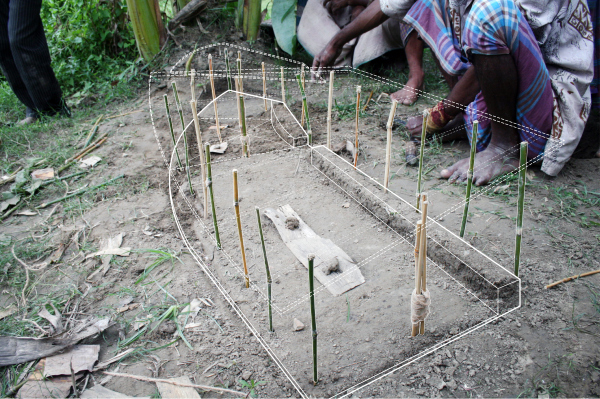A Young Architect’s Process from Concept to Construction to Cigarette
by Chi-Chi Lin
My very first internship was in Bangladesh with Panigram Resort, an eco-boutique resort in a rural farming town outside of Jessore, Bangladesh. I had no idea that it would ignite in me an insatiable curiosity about South Asia that would lead me to return to the region several years later. I arrived in Kerala, India in 2012 not only with the amazing opportunity to return to a similar tropical biome and region, I also returned to the same hospitality and resort family! The Raxa Collective, an organization that promotes entrepreneurial conservation, collaborates with Panigram Resort to help train Panigram Resort’s future leadership and staff.
When I was working at Panigram Resort, I was tasked with building a temporary pavilion for hosting potential investor meals and events. It seemed like an uphill battle for me at the time: I was young (19 years old); I was female; and I was a foreigner. Who would listen to me? I recently shared my story and was awarded the Young Designers 2014 Award by the Indian Architects & Builders (IA&B) magazine. I hope you, too, will enjoy my anecdote about the process from concept to construction … and finally, acceptance.
I have never felt more accomplished than when I was handed a cigarette. Of course that requires an explanation.
Leading a team of up to twenty local laborers, I erected my first structure before I turned 20. I was not only an architecture intern but also the engineer, the site surveyor, the purchasing estimator, and the project manager of the riverside banquet pavilion that started as a stick and string model. Despite these responsibilities, I was constantly reminded that I was “just a young girl.” To realize my envisioned pavilion within a tight timeline of 6 weeks, I had to overcome barriers to gain the respect of my all-male team.
As a guest, I was expected not to command. As a university-educated individual, I was expected not to labor. As a 19-year old, I was expected not to instruct mishteri with decades of experience. And as a woman, I was expected not to talk. I once noted that a circle has only one center point only to be swatted away, “close your mouth.”
Relying on a plastic tube with river water as a level and leaves as rulers, I had to monitor quality closely. The difference of an inch could become exponentially problematic. I was usually left alone on site so I learned Bengali to communicate my vision and concerns: crooked posts, uneven stairs, misaligned slats. “You say this not okay, that not okay. How to finish?” the mishteri snapped. I didn’t know enough Bengali to answer a “how” question, but I knew enough to be adamant: “Please do it or it will not be beautiful.”
I persevered. The innovative design proved my skills as an architect. The site selection showed my eye for developing the potential of a site. The effective execution of the project timeline proved my abilities as a leader. I worked alongside the men, stomping through cow dung mixing mud, trimming bamboo with a machete, and wading through the river hoisting timber. This challenged the male ego and got the workers on their feet. Unbelieving villagers gathered to watch from behind the jute reeds. Soon, the workers approached me to confirm details. They invited me to tea stalls. They called me chotto, “little boss”.
One day, Mukul retrieved two cigarettes, something that when shared symbolized respect and acceptance as a team member. I took my cue to leave, but he stopped me. “Chotto boss, cigarette?”
[author] [author_image timthumb='on'][/author_image] [author_info]Chi-Chi Lin is a designer and do-er currently working in business development and design at BIG - Bjarke Ingels Group - in New York. Chi-Chi Lin has led two international award-winning design-build projects from concept to construction in Bangladesh and South Africa and hopes to continue exploring architecture in multi-disciplinary contexts.[/author_info] [/author]



